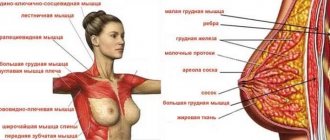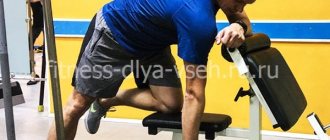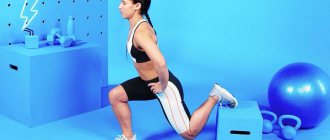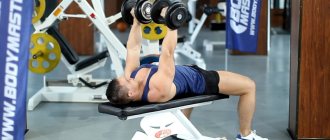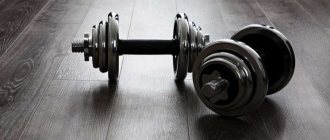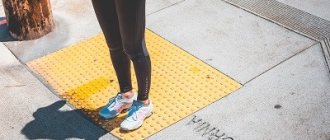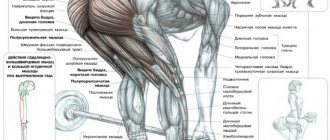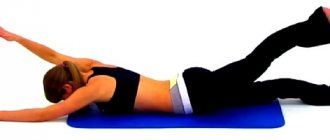For beginner athletes, it is easier to do lunges not with a barbell, but with dumbbells. It is impossible to balance with a barbell by slightly spreading and bringing your arms together, as with dumbbells.
Lunges with dumbbells can be called one of the most effective basic exercises for developing the muscles of the thighs and buttocks. Compared to squats, lunges allow you to concentrate the load on one leg and work the muscles more thoroughly.
Dumbbells in exercise
The high position of the barbell on the shoulders makes the athlete a long lever, which is difficult to keep in balance, and dumbbells in lowered hands during execution are lower than the center of gravity of the body, so it is easier to balance with them.
In case of loss of balance, it is more difficult and difficult to throw a barbell from your shoulders than to throw dumbbells by simply unclenching your fingers - lunges with a barbell require considerable dexterity, which comes with experience.
Holding a barbell on your shoulders creates a load on the spine, and if a beginner cannot keep his back straight due to a weak muscle corset and undeveloped technique, then the harmful load on the spine increases greatly. Therefore, the optimal solution for a beginning athlete is lunges with dumbbells.
Muscle groups involved
Lunges are a basic leg exercise. Depending on its type and different directions: forward, backward or to the side, many muscle groups work in it.
But mainly the load falls on:
- quadriceps;
- gluteal muscles;
- thigh biceps.
Auxiliary loading:
- calf muscles;
- back straighteners;
- abdominal muscles.
Lunges are single-leg concentrated squats. The farther one leg is extended forward and the other back, the more load will be placed on the hamstrings and gluteal muscle of the front leg, and the shorter the step, the more the quadriceps will be loaded.
The benefits of lunges
Unlike squats with heavy weights, lunges with dumbbells are primarily aimed not at increasing muscle mass, but at creating relief. Therefore, people with insufficient volumes, in their opinion, need to combine lunges with heavy squats.
Namely:
- Lunges effectively create separation of the buttocks from the hamstrings, which, as survey statistics show, is the most important attribute of sexual attractiveness for both women and men. But do not forget about other leg exercises aimed at developing strength, mass and detail, which must be included in the training program;
- While performing lunges, in addition to tension and contraction of the muscles, it is stretched. Moreover, this applies not only to the buttocks and muscles of the back of the thighs, but also to the front. The quadriceps is stretched when the leg is pulled back at the bottom, and the hamstrings and gluteal muscles are stretched when the leg is placed forward during a squat;
- An important advantage of dumbbells over a barbell is the fact that exercises with dumbbells can be done at home, since dumbbells are easier to keep at home. In addition, dumbbells are cheaper than barbells with racks;
- As a highly dynamic movement that engages multiple stabilizer muscles, lunges are an excellent workout for developing balance and coordination.
Recommendations for implementation
The first thing I want to talk about is the possibility of shifting the load on one or another part of the muscles.
- For example, turning the foot inward will place the load on the outer thigh.
- If you move your knee forward (which, by the way, increases the traumatic nature of the exercise), the emphasis of the load will shift to the medial muscle.
But you need to understand that you can only change the position of the foot and body in exercises on the spot, that is, when performing a farmer's walk, you cannot change the technique and position of the body.
So, lunges with dumbbells are an excellent leg training exercise that should be included in the training process after heavy compound exercises, such as squats with a barbell or leg press in a machine.
- The best scheme for men to gain weight is considered to be three to four sets of eight to twelve repetitions. Be sure to do a warm-up approach.
- Girls can perform the exercise with minimal weight for three to four approaches, 15-20 repetitions each.
- The exercise can also be used in workouts aimed at losing weight. In this case, you should increase the number of repetitions to twenty to twenty-five. In this case, short breaks should be taken between approaches, lasting no more than one minute.
- Lunges with dumbbells are a good superset and can be performed in conjunction with squats or leg presses.
Execution technique
- For people with vestibular disorders, it is better to perform the exercise option on the spot. For those who have a good sense of balance, lunges can be done with movement.
- The option with advancement requires more energy than the one performed on the spot. Therefore, a type of exercise in motion, simultaneously with developing muscle definition, can be used to burn excess fat.
- It is important to pay attention that the knee of the forward leg does not go beyond the level of the toe, and the angle of the maximally bent front leg is no sharper than 90° . Otherwise, there will be a harmful load on the knee joints.
- To avoid harmful stress on the spine, you must keep your back straight with your shoulder blades together. You need to look forward so as not to lose your balance.
The number of repetitions should be done 15–20 in 3–4 approaches, if the repetitions in the approach are done alternately with different legs. If you perform a set of several repetitions with one leg first, and then the other leg, you need to do 8-10 repetitions for each leg.
Analysis of the exercise
Anatomy of exercise - which muscles work
Main muscles:
Accessory muscles:
Advantages
Flaws
Preparing for the exercise
A targeted warm-up should be a mandatory part of a training program that includes lunges with dumbbells in place. It should include, firstly, gymnastics for the knee joints, and secondly, high-quality warming up of the working muscles. For this purpose, you can perform stretching of the hamstrings and quadriceps, as well as 2 sets of exercises with your own weight or with small dumbbells.
Proper execution
Errors
Efficiency Tips
Inclusion in the program
Lunges with dumbbells can be included in the training program “as” the main movement (in some “female” complexes), but more often – as a finishing exercise.
The load should also be selected according to the goals. In the first case, the working weight should be such that the last repetitions are difficult. In this case, the volume of the approach varies in the range from 8 to 10 repetitions.
“Formative” approaches are traditionally more voluminous - from 12 to 15 repetitions, but are performed with less weight.
As for those who are learning the movement for the first time, initially they should not pay attention to the working weight. Quite the opposite – it’s easier to learn movement techniques and develop the necessary coordination skills without using additional load.
Contraindications
- As with other knee-dominant movements, the knee joints and ligaments are the most vulnerable area in lunges. In other words, any deviations in their functional state or simply injuries make it difficult to safely perform the exercise. The static lunges discussed in this article are the most “gentle” for the knee joints - they reduce the impact load that occurs when performing a step.
- Athletes with vestibular system disorders may experience difficulty performing lunges. In this case, it is recommended to perform lunges with dumbbells in one hand and hold onto a support with the other (a wall bar, for example). If your level of physical fitness allows, you can also perform lunges in a Smith machine - with a fixed bar it will be easier to maintain balance.
How to replace the exercise
It is important to understand that finding a worthy alternative to this exercise due to the “scale” of its training effect on the muscles is not easy.
More experienced athletes can replace lunges with dumbbells with an exercise with a barbell - the effect on the target muscles is similar, but the weight load can be increased.
[su_posts template=”templates/teaser-loop.php” id=”1458,744,1364,526" tax_operator=”0" order=”desc”]
Lunges for men
By nature, men have a more developed upper body than women. And in women, the lower part predominates in strength.
The mass of muscles directly depends on their strength, so in women, as a rule, the buttocks and thighs are proportionally larger than the rest of the muscles, and in men, in most cases, the opposite is true.
Here, men will benefit from lunges, which help make the buttocks more convex and rounded, and refine the hamstrings, which give the legs a complete look. Lunges are also essential training for striking, moving and wrestling attacks in various combat sports.
Tips and tricks
- Before training, you need to warm up and stretch, and after training, cool down and stretch. To warm up the muscles, you can do squats without dumbbells and bend your torso forward;
- while standing or sitting on the floor are suitable for stretching the hamstrings and gluteal muscles To stretch the quadriceps, you need to grab your foot with your hand, with the knee bent as much as possible and the leg of the same name laid back. Gently pull your leg back, feeling the stretch in the quadriceps femoris muscle. You need to hold on with your other hand to maintain balance. Hold the quadriceps stretched for a few seconds and repeat for both legs several times;
- It's better to start with lunges in place. After mastering this technique and confidently performing it, you can proceed to the variation in motion. Lunges are performed either with different legs alternately, or first with one leg for the required number of repetitions, and then with the other leg;
- It is optimal to do more than one type of lunge from workout to workout, and not to fill one session with all types of exercise, but regularly, about once a month, change the options to diversify the effect on the muscles.
Lunges: technique and main types
Lunges are one of the most difficult exercises from a technical point of view, so to achieve the effect of training, it is important to study all the nuances of the technique. You can perform lunges without equipment, with dumbbells or a barbell, gradually increasing the weight of the weights. Since lunges have many modifications, you can even create a full workout for your legs and buttocks, consisting of lunges alone! But before you perform lunges with dumbbells or a barbell, hone the technique of this exercise without additional weights.
Technique for performing the lunge exercise:
- During the entire lunge cycle, you should keep your upper body in an upright position: back straight, shoulder blades retracted, stomach tucked, shoulders down. The gaze is directed forward.
- The front and back legs should be bent so that the thighs and shins form a right angle. There should also be a right angle between your body and the thigh of your front leg.
- The thigh of the front leg in a lunge should be parallel to the floor, with the knee not extending beyond the toe. The knee of the back leg is a few centimeters from the floor, but does not touch it.
- The step forward when lunging should be wide enough and amplitude. Lunges with a narrow step put more stress on the quadriceps, while lunges with a wide step put more stress on the buttocks.
- It is important to distribute your weight evenly between your two feet, placing a little more weight on your front foot. To maintain balance, turn the toe of your front foot slightly inward. When returning to the starting position, push off the floor with your heels.
- As you lunge, engage your gluteal and hamstring muscles. They should be tense and you should feel a stretch in your gluteal muscle. To do this, you can bend your lower back a little.
- It is better to perform lunges first on one leg, then on the other. There is an option to perform alternate lunges, but this is technically more difficult and reduces the load on the gluteal muscle.
- Stay focused throughout the exercise to maintain balance and avoid injury.
The lunge exercise can be performed with dumbbells (arms with dumbbells are lowered down along the body) or with a barbell (the barbell is located on the shoulders behind the head). If you are doing the exercise without weights, keep your hands at your waist or clasp them together in front of you to maintain balance. If your training plan includes squats, then it is better to perform lunges after them.
We offer you the main types of lunges that you can include in your workout in the gym or at home. The pictures show lunges performed without equipment, but you can use dumbbells or a barbell.
Classic lunge
The classic lunge is a very effective exercise for working the gluteal muscles, quadriceps and inner thighs. Beginners should especially pay attention to the technique of performing the exercise, since it is very difficult.
How to do it:
Stand straight with your legs slightly apart so that your foot, knee, hip, and shoulders form a straight line. As you inhale, take a step forward and shift your weight to your front leg. The thighs and shins of both legs form a right angle. As you exhale, push your heel off the floor and, using the muscles of your buttocks and hamstrings, return to the starting position.
Lunge in place
Compared to classic lunges, the standing lunge targets the quadriceps more than the glutes. This modification of the lunge is very useful for beginners, since this exercise is technically easier to perform than the classic lunge.
How to do it:
Take a wide step forward with your front foot fully flat on the floor and your back foot on your toes. The weight is evenly distributed between the two legs. As you inhale, slowly lower the knee of your back leg toward the floor so that the thigh and shin of both legs form a right angle. Hold for a few seconds and exhale as you return to the starting position.
Reverse Lunge
Compared to classic lunges, the reverse lunge puts less stress on the knee joints, so it is recommended for those who want to reduce stress on the knees. The reverse lunge also gives a good workout to the hamstrings.
How to do it:
Stand straight with your legs slightly apart so that your foot, knee, hip, and shoulders form a straight line. As you inhale, take a step back, placing the bulk of your weight on your front supporting leg. The thighs and shins of both legs form a right angle. As you exhale, return to the starting position.
Bulgarian lunge
The peculiarity of the Bulgarian lunge is that during its execution the load is not distributed between the two legs, but goes entirely to the front leg. Therefore, the Bulgarian lunge puts more tension on the leg muscles than a standing lunge or a classic lunge. In addition, during the Bulgarian lunge, the quadriceps is in constant work from the beginning of the exercise to the end, without relaxing. The deeper you go into the Bulgarian lunge, the more stress your gluteal muscles receive.
How to do it:
Place your back foot on a bench, chair, or step platform, resting your toe on the surface. The weight of the body rests on the supporting leg. As you inhale, slowly lower the knee of your back leg toward the floor so that the thigh and shin of both legs form a right angle. If necessary, adjust the position of your front leg relative to the bench, moving it back or forward. Hold for a few seconds and exhale as you return to the starting position.
Diagonal Lunge
The diagonal lunge is an exercise that is very useful for girls. It uses the gluteal muscles, as well as the outer and inner thighs, which means it helps to work on all problem areas.
How to do it:
From a standing position, transfer your weight to one leg, and with the other leg, inhale, take a wide step back diagonally. The toe of the front leg can be turned slightly outward, the toe and knee of the back leg can be turned slightly inward. The knee of the front leg does not extend beyond the toe, the thighs and shins of both legs form a right angle. At the bottom of the squat, you should feel a stretch in the gluteal muscles of the supporting leg. Then push up with your heel and, as you exhale, return to the starting position. You can perform this exercise with each leg alternately, or first on one leg, then on the other.
How to replace lunges with dumbbells?
This question may arise for at least two reasons:
- Unavailability of dumbbells. When there are no dumbbells nearby and there is no way to find them, but you need to train so as not to get out of your sports schedule, in this case you can use any weights that are the same in weight and that can be held in your hands. It is convenient to use water bottles with handles or buckets, as you can adjust their weight by pouring different amounts of water or pouring something loose.
- Contraindications for health reasons. If lunges are not recommended by a doctor due to problems with the knees, then with the doctor’s permission, the exercises can be replaced with others that load the same muscles separately, or in a slightly different way: swinging your legs in different directions with weights;
- deadlift on straight legs;
- leg press;
- leg curls;
- squats;
- exercise “gluteal bridge”;
- hyperextension.
Exercise options
Cross Lunges
The movement is similar to a curtsy, it is also called cross or side lunges, as well as scissors. Loads the gluteus maximus and quadriceps muscles. Thanks to the unique positioning of the legs, there is a good stretch of the buttocks and biceps of the thigh.
The movement technique is quite difficult for beginners, requiring a certain flexibility and the ability to maintain balance, so for the first time it is better to do “curtsies” without dumbbells.
Technique:
- If you have experience in performing the exercise, take dumbbells and hold them in your arms at your sides near your hips;
- Starting position – feet slightly wider than shoulders, toes slightly apart, back straight, gaze directed forward;
- Shift your body weight to one leg;
- Step back with the second leg and move it beyond the line of the supporting leg, the back leg moves diagonally;
- Lower yourself into a squat, the front leg should be bent at a right angle, its thigh parallel to the floor, the knee does not protrude beyond the line of the toe, the support rests on the heel;
- The back leg rests on the toe, its knee is near the floor, but does not touch it;
- Feeling a stretch in the buttocks and biceps femoris, stand up from the squat and return to the starting position;
- Do the same with the other leg or perform the required number of repetitions with one leg at once, and then several repetitions with the other leg.
Bulgarian lunges
A heavier version of the exercise. The back leg is not on the floor, but on an elevated support, and the front leg bears most of the body weight.
The knee of the front leg at the lowest point is bent at a right angle and does not protrude beyond the toe. The rear leg platform should be stable and approximately knee height. It is better to use an athletic bench.
This option is performed on the spot - no step is taken before each squat. These can be not only “Bulgarian lunges”, when placing the back leg on a hill, but also ordinary ones, when both legs are on the floor.
Walking Lunges
A variation of the exercise is performed in steps while squatting.
After the lunge, the front leg returns back to the starting position with the legs shoulder-width apart parallel to each other.
Then the stepping lunge is done with the other leg. Do the required number of repetitions and approaches.
Lunges in motion
Here, after each step, the legs do not return back to their original position, but make a linear movement as when walking. It is necessary to provide in advance the necessary free space for the lesson.
The travel distance will be approximately based on 10 large steps:
- Take dumbbells in your hands, stand straight, feet shoulder-width apart, look ahead, back straight;
- Take a step forward, pointing the toe of your front foot slightly inward;
- Lower into a squat, bending the front leg to a right angle, the knee does not protrude beyond the toe;
- The hind leg rests on the toe at the lowest point, its knee almost touches the floor;
- Smoothly push off with your back leg, shift your weight forward and take a step with your other leg;
- Do a squat with the other leg in front;
- Perform the required number of repetitions and sets.
Lunges on a bench
This exercise is also called “stepping onto a bench.”
It, like the Bulgarian lunges, is complicated, but differs in three points:
- The bench is located in front of the athlete, not behind and, accordingly, the front leg is placed on it, not the back.
- The starting position is the front leg already bent at a right angle, and in Bulgarian lunges it is straight.
- The back leg, standing on the floor, is straight in the starting position, but in Bulgarian lunges it is bent, which means that the quadriceps is stretched during the exercise.
When stepping onto the bench, you should try not to push off the floor with your back foot, but to lift the weight with your front foot. In this form, as in the “Bulgarian” version, maximum stretching of the hamstrings and gluteal muscles occurs.
Lunges with a barbell
This variety is suitable for advanced athletes who require a lot of weight, but there is no fundamental difference between it and the option with dumbbells.
Using a barbell on the shoulders requires not only a certain strength to hold a heavy projectile, developed coordination and dexterity, but also responsibility for the correct position of the back.
Rounding the spine is fraught with injury, so you need to start with a light barbell weight, and then use a reasonable weight that allows you to perform the movement technically flawlessly.
Lunges for girls[p[edit | edit code]>
The lunge is a compound exercise because it moves the hip, knee, and ankle joints. As a result, not only the quadriceps muscles of the thighs work, but also the gluteal muscles, the back muscles of the thighs and the muscles of the legs.
Exercise technique[p[edit | edit code]> - From a standing position with your legs together, take a step forward with your right foot. To begin, lower yourself about 20 centimeters. As you get stronger, you will be able to increase your range of motion to make the exercise more difficult.
- When you reach the bottom of the movement, push your right foot off the floor and return to the starting position. To maintain constant muscle tension, do not straighten your right leg completely.
- Repeat the exercise on your right leg the required number of times.
- Repeat the exercise on your left leg with minimal rest between sets.
Beginners, if they lack flexibility, can bend their back leg at the knee. As you master this exercise, the muscles will become more and more elastic. You can increase the load by gradually straightening your back leg more and more.
If you've never done a lunge before or you think you might have trouble with your balance, use your hand to hold onto something solid, such as a wall or chair. At a certain level of mastery of the exercise, you will be able to keep your hands on your hips, which will allow you to train not only your muscles, but also your balance.
Advantages
- Allows you not only to build muscle mass, but also to stretch muscles.
- If you have to choose only one leg exercise, choose lunges: they work the quadriceps, hamstrings, and glutes.
- Does not require a large amount of sports equipment.
- Bodyweight lunges place very little stress on the lower back. But even lunges with weights are much safer for the spine than squats.
Flaw
- With this exercise, you work each leg alternately, which takes more time.
The wider the step [and [or smaller, as mentioned above?] the greater the weight of the burden, the greater the load on the knee.
Recommendations
Recommendations
- Place your free hand (if you have one) on the muscles you want to highlight (glutes or quadriceps) to better feel the contraction.
- Because the lower back muscles are stretched with every step, you tend to arch your lower back when performing lunges. Pay attention to the position of the spine, especially if you work with weights.
- The greater the distance between the legs, the greater the load on the gluteal muscles and the back muscles of the thighs. The same effect can be achieved by slightly
forward (shifting the body too much forward transfers the load from the gluteal muscles to the quadriceps and adds stress to the lumbar muscles). - Narrower foot placement allows for greater use of the quadriceps muscles.
Options[p[edit | edit code]> - The distance between the legs determines the range of motion. Start with a small step, but one in which the knee of the leg in front is located no further than the toes of that foot (otherwise the knee joint receives too much stress). This will help you master the exercise better. To make it more difficult, gradually increase your stride length. You can take a step forward or backward - as you wish.
- You can either alternate legs each rep, or perform the entire set on one leg and then repeat the exercise on the other leg.
- As you come out of the lunge, straighten up fully and assume a standing position with both feet on the floor.
- Increase the load: hold a dumbbell in each hand or place a barbell on your shoulders.
Lunge Option
- If you're training in a large room, lunge the entire length of the room. You can also do lunges on a treadmill.
- Instead of a forward lunge, you can perform a side-step lunge. This exercise is harder on the knees, but it uses the hip adductors more actively than regular lunges.
Lunge to the side
- To complicate this exercise, you do not need additional weights. By placing your working leg on the bench, you will increase the load on the thigh muscles without burdening your spine.
Lunge Option
Contraindications for implementation
For all its benefits for appearance, strength and health, lunges with dumbbells can still cause any harm in the following cases:
- diseases of the knee joints;
- high blood pressure;
- heart disease;
- problems with the spine, such as osteochondrosis, hernias, protrusions.
In addition to consulting a doctor before training, it is better to conduct classes under the supervision of an experienced instructor, in this case there will only be benefits.
Benefits and disadvantages of exercise
- This is an effective way to develop the target muscle group.
- This exercise allows you to make your legs more aesthetically pleasing.
- Helps increase muscle strength, volume, endurance and cardiovascular health.
- Lunges with dumbbells are suitable for athletes of any level of training. For proper execution, the main thing is to choose the optimal weight.
- When performing the exercise, almost all the muscles of the body are involved in the work.
- Lunges with dumbbells are a compound exercise that targets many muscle groups and joints.

